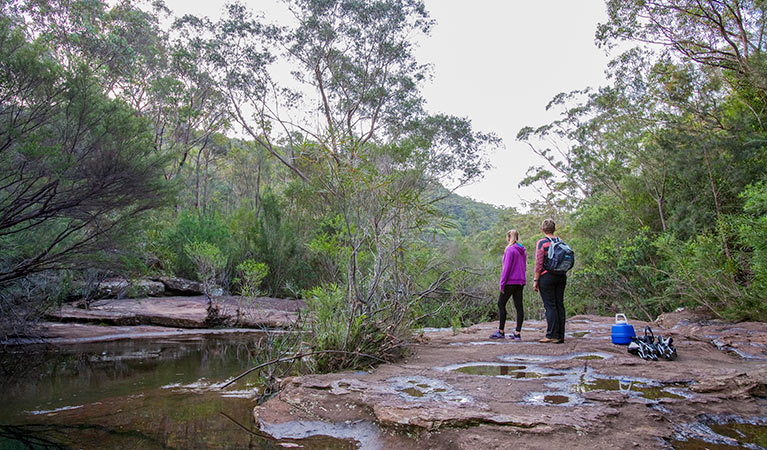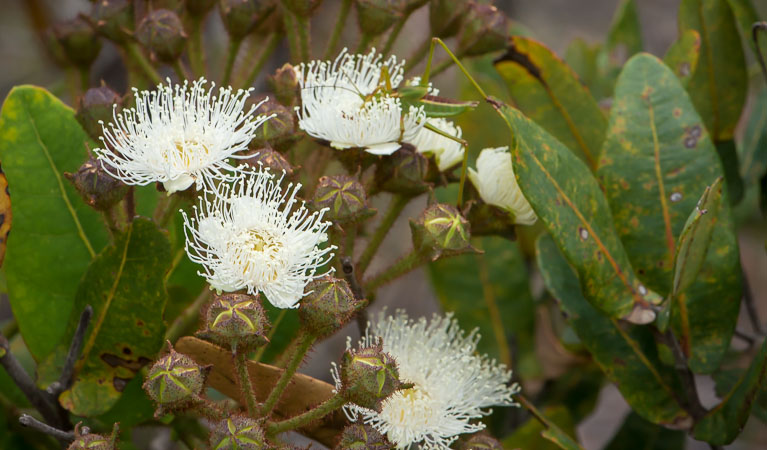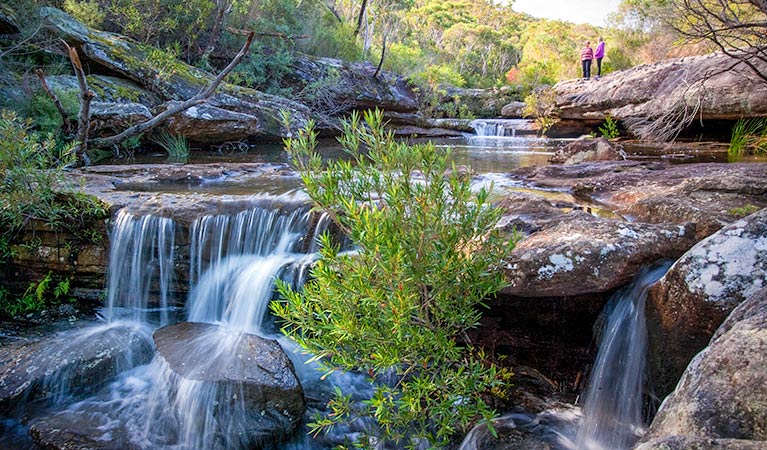Heathcote National Park
Overview
Visit Heathcote National Park near Waterfall in southern Sydney for self-sufficient bushwalking or camping. The park is easy to access and popular for mountain biking, hiking and waterholes, making for a great daytrip.
Read more about Heathcote National Park
Enjoy bushwalking amid the rugged beauty of the Australian bush at Heathcote National Park, in the south of Sydney, adjacent to Royal National Park. The park is known for magnificent native vegetation and wildlife, rocky outcrops, and hidden freshwater pools. Heathcote is a great place for mountain biking along Pipeline trail, and is within easy reach of Sydney and several train stations.
Seasoned bushwalkers will enjoy excellent walking tracks, as well as bush camping at Kingfisher Pool. The northern end of the park offers a short walk from Heathcote down to Mirang Pool picnic area. This park has limited facilities so it's ideal for those who are comfortable with self-sufficient and relatively isolated walking and camping experiences.
Local alerts
For the latest updates on fires, closures and other alerts in this area, see https://uat.nswparks.cloud/visit-a-park/parks/heathcote-national-park/local-alerts
Map

Map legend

Contact
- in the Sydney and surrounds and South Coast regions
Heathcote National Park is open sunrise to sunset but may have to close at times due to poor weather or fire danger.
-
-
Royal National Park Visitor Centre
02 9542 0648
1300 072 757 for campground and cottage bookings
Contact hours: 8.30am to 4.30pm daily. Closed Christmas Day. - 2 Lady Carrington Drive, Audley, NSW 2232
-
Email: npws.royal@environment.nsw.gov.au
-
Royal National Park Visitor Centre
Visitor info
All the practical information you need to know about Heathcote National Park.
Maps and downloads
Nearby towns
Heathcote (3 km)
Just 36km south of Sydney, Heathcote offers easy access to Heathcote National Park and Royal National Park – the world's second-oldest national park. The heritage-listed Royal National Park offers a range of recreational activities – including bushwalking, cycling and surfing – and places to relax and enjoy a meal in natural surroundings.
www.sutherlandshire.nsw.gov.au
Parramatta (42 km)
Parramatta offers a fascinating insight into early colonial life in Australia. Don't miss a visit to Old Government House, now one of 11 Australian Convict Sites on the UNESCO World Heritage list.
Sydney City Centre (46 km)
No trip to Sydney is complete without spending some time in the city’s beautiful parks. Whether it’s in central areas like Hyde Park or the Royal Botanic Gardens or further out in Centennial Parklands, there’s plenty of green space to go out and enjoy.
Learn more
Heathcote National Park is a special place. Here are just some of the reasons why:
The great outdoors

Slow down and forget your cares with a freshwater swim. Try Kingfisher Pool, Mirang Pool or Lake Eckersley. Or check out the pretty rockpools and waterfalls where Heathcote Creek meets the Woronora River. Cycle along Pipeline Road to the Sarahs Knob picnic area, where you can also complete a great hill run. The 2250ha park is less than an hour from central Sydney by car or train. The park adjoins Royal National Park, just west of the Princes Highway and South Coast train line. However, once you're inside you'll forget about transportation - the park is beautiful, quiet and secluded, plus, it's a vehicle-free zone. If you love to bushwalk, then Heathcote is your kind of park. A multitude of walking tracks criss-cross the park, including the Heathcote to Waterfall track linking Heathcote and Waterfall train stations.
- Kingfisher Pool picnic area A visit to this Sutherland picnic spot, located at Kingfisher Pool campground in Heathcote National Park, near Waterfall, offers birdwatching, bushwalking and swimming.
- Mooray walking track Enjoy a day of Sydney bushwalking and birdwatching. One of the best walks in Heathcote National Park, Mooray walking track is easily accessed from Waterfall train station.
The beauty of the bush

Heathcote National Park is a rugged landscape, flourishing with a variety of plants and animals. Eucalypts such as bloodwood, grey gum, Sydney peppermint, and scribbly gum dominate open forest areas alongside pockets of bright flowers like banksias, hakeas, and waxflowers, which are best enjoyed along a relaxing bushwalk. With so much plant life to admire, it’s no wonder wildlife like sugar gliders, ringtail possums and swamp wallabies also call Heathcote home. A soundtrack of chatty friar birds, honeyeaters and lyrebirds can also be heard across the park gorges during winter.
- Bullawarring walking track For great Sydney bushwalking, visit Heathcote National Park, near Waterfall in the Sutherland shire; combine your hike with birdwatching and freshwater swimming.
A long and varied history

The area was for years home to local Aboriginal people, and you can still see several Aboriginal rock engraving sites. In 1937, a bushwalking group leased a section of what is now national parkland to protect this important area of bush. This section and its surrounds became known as the Heathcote Primitive Area (1943). This was expanded again and renamed Heathcote State Park (1967). In 1974, the area became Heathcote National Park.
Plants and animals protected in this park
Animals
-

Eastern blue-tongue lizard (Tiliqua scinciodes)
The eastern blue-tongue lizard, one of the largest skinks in Australia, is found throughout most of NSW. When threatened, the eastern blue-tongue lizard displays its blue tongue in a wide-mouthed intimidating show. Not an agile animal, they feed on slow-moving beetles and snails.
-

Yellow-tailed black cockatoo (Calyptorhynchus funereus)
The yellow-tailed black cockatoo is one of the largest species of parrot. With dusty-black plumage, they have a yellow tail and cheek patch. They’re easily spotted while bird watching, as they feed on seeds in native forests and pine plantations.
-

Koala (Phascolarctos cinereus)
One of the most renowned Australian animals, the tree-dwelling marsupial koala can be found in gum tree forests and woodlands across eastern NSW, Victoria and Queensland, as well as in isolated regions in South Australia. With a vice-like grip, this perhaps most iconic but endangered Australian animal lives in tall eucalypts within a home range of several hectares.
Plants
-

Grass tree (Xanthorrea spp.)
An iconic part of the Australian landscape, the grass tree is widespread across eastern NSW. These Australian native plants have a thick fire-blackened trunk and long spiked leaves. They are found in heath and open forests across eastern NSW. The grass tree grows 1-5m in height and produces striking white-flowered spikes which grow up to 1m long.
-

Old man banksia (Banksia serrata)
Hardy Australian native plants, old man banksias can be found along the coast, and in the dry sclerophyll forests and sandstone mountain ranges of NSW. With roughened bark and gnarled limbs, they produce a distinctive cylindrical yellow-green banksia flower which blossoms from summer to early autumn.
-

Scribbly gum (Eucalyptus haemastoma)
Easily identifiable Australian native plants, scribbly gum trees are found throughout NSW coastal plains and hills in the Sydney region. The most distinctive features of this eucalypt are the ‘scribbles’ made by moth larva as it tunnels between the layers of bark.
Environments in this park
Education resources (1)
What we're doing
Heathcote National Park has management strategies in place to protect and conserve the values of this park. View the detailed park and fire management documents. Here is just some of the work we’re doing to conserve these values:
Preserving biodiversity
Endangered animal habitats are found in Heathcote National Park. NPWS is committed to the protection and conservation of these endangered species, and works to educate visitors wherever possible. Directional signage is positioned and maintained around the park.
Managing weeds, pest animals and other threats
Pests and weeds have a significant impact to the ecosystems within Heathcote National Park. Pest reduction of introduced species, as well as ongoing risk assessment for new and emerging weeds, is an important part of the work NPWS does to protect the biodiversity values of this park.
Developing visitor facilities and experiences
Heathcote National Park is equally committed to park conservation and visitor enjoyment. NPWS works to provide clean, safe facilities for visitors to enjoy and aims to inform the public about sustainably using this park. NPWS monitors the effects of recreational access on the park’s natural and cultural assets, and implements actions to prevent negative impacts, as required.
Managing fire
NSW is one of the most bushfire prone areas in the world as a result of our climate, weather systems, vegetation and the rugged terrain. NPWS is committed to maintaining natural and cultural heritage values and minimising the likelihood and impact of bushfires via a strategic program of fire research, fire planning, hazard reduction, highly trained rapid response firefighting crews and community alerts.

